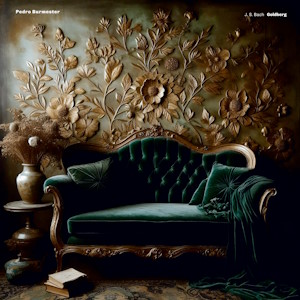
Johann Sebastian Bach (1685-1750)
Goldberg Variations (1741)
Pedro Burmester (piano)
rec. 2024, Estúdios Valentim de Carvalho, Paço d’Arcos, Portugal
Artway Next 008-2024 [54]
Recordings of this perennial favourite masterpiece continue to appear regularly; I have over the last year reviewed two by Luiza Borac (review) and Hannu Alasaarela (review), and now comes the distinguished Portuguese pianist Pedro Burmester who, according to the promotional literature, “recorded the Goldberg Variations 32 years ago for EMI Classics and is revisiting it now full of energy and with a more mature way of looking into one of Bach’s most important pieces.”
Unusually for these days, Burmester plays this without repeats, whereas I prefer to hear them. His manner is generally very direct and swift, too, with a minimum of decoration; as a result, the running time is a fairly hasty 54 minutes, close to Gould’s second recording but with more of a sense of “stop-go”. The first variation is very heavy-handed and percussive; indeed, just occasionally, I feel that Burmeister’s approach flirts with the perfunctory, bordering on a deliberate insensitivity. That emphatic manner is sustained throughout and when he is in more urgent mode, I like to hear a little more breathing space through and between phrases. The momentum of no. 5, for example, exactly matches Glenn Gould’s breathless, headlong delivery in his first recording, both taking a mere 37 seconds, but Gould is more fluid, less dogged, and hence more elegantly propulsive. In No. 7, Burmester slows down markedly, exaggerating the rubato and beginning to sound mannered; on the other hand, his capacity for prestidigitation, is admirable and indeed exciting, and I must remark on the pleasure afforded to the listener by his bright, bell-like tone and the precision and regularity of his trills in, for example, No. 10. However, remarking on single, isolated aspects of a pianist’s playing is like stopping to admire individual trees in a wooded landscape…
My mystification is compounded by the execution of variation No. 11, which is played in a halting, staccato manner which I find quirky and disconcerting; it is obviously deliberate but I find that very deliberateness musically unsatisfying. Then again, I then find myself thoroughly enjoying the drive of No. 14, which is thrillingly executed; having savoured that, I am irritated by the ponderousness of his execution of the next variation. It is this erratic nature of Burmester’s treatment of successive variations which prevents me from settling into a “listening groove” while hearing this recital, if you follow me – although others may well be charmed by its mercurial quality. Some variations are ideal, some puzzling, others bordering on the perverse. There is such a contrast, for example, between the perkiness of the opening of Gould’s No. 19 and the plodding nature of Burmester’s, then suddenly the latter doubles the tempo only to slow it right down again, all within the space of one minute and 37 seconds; it signals the desire to sound original but ends up wilfully drawing too much attention to that originality. Then again, the brilliance of the runs in No. 20 is astounding.
This is the pattern throughout, so let me jump forward to the longest and most celebrated variation, the “Black Pearl”, No. 25. Burmester’s delivery of this is oddly four square and prosaic, devoid of mystery or profundity. It is not a question of its timing, which is conventional, but rather of its phrasing. Typically, then, the virtuosity and fluency of Burmester’s playing of the fiendish No. 29 are enough to buy forgiveness for any preceding failings and the reprise of the opening aria is so assured: serenity incarnate, perfectly poised.
The recording is ideally clear and balanced, the piano not being too close but the tone still emerging as crystalline; too often these day listeners can feel as if their heads are under the hood or be distracted by heavy breathing, humming and clicking nails.
In sum, for all its virtuosity, I find this an oddly inconsistent and at times quirky and mannered reading which is suggestive of the music having been overthought. I have listened to scores of Goldberg recordings and repeated listening to this one has not reconciled me to its style; I would not include it among those I recommend in my survey or endorse it over Alasaarela’s version referenced in the opening paragraph above. However, in the end, that is just my response; it may be that I am too conventionally entrenched in my tastes and others might be far more engaged and intrigued by the new perspectives Burmester brings to this endlessly fascinating work.
Ralph Moore
Availability: Artway


















